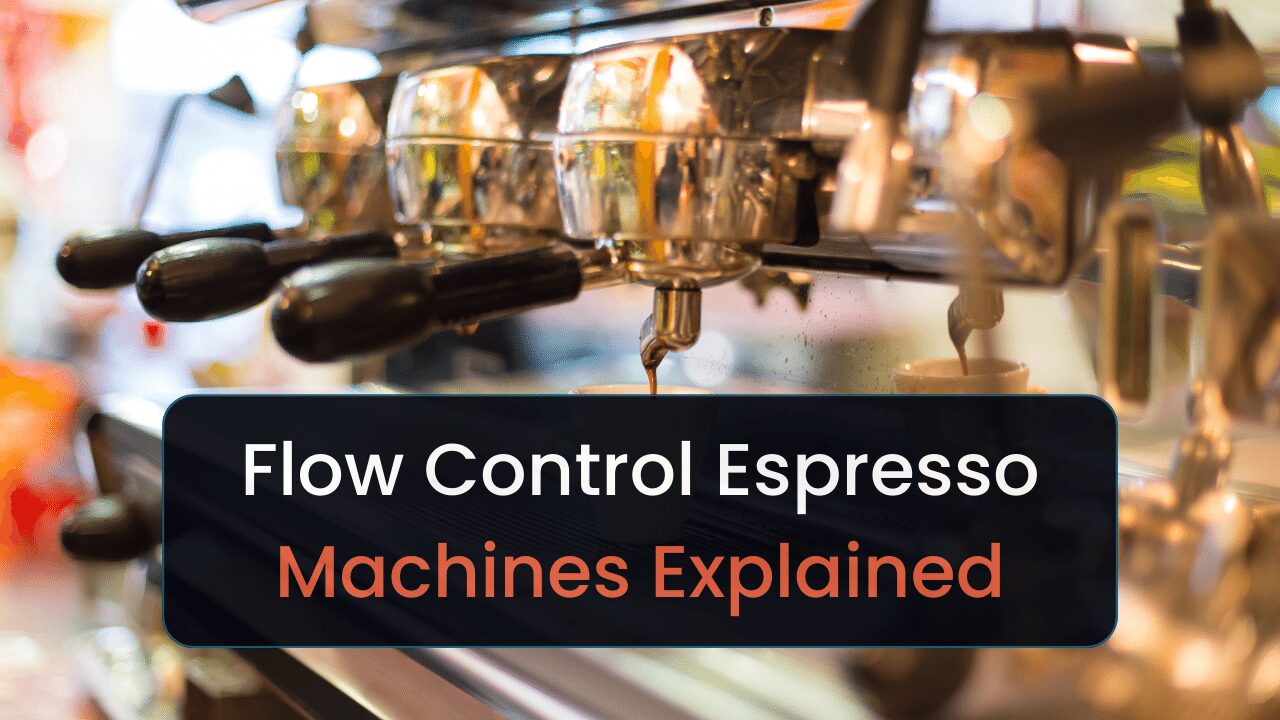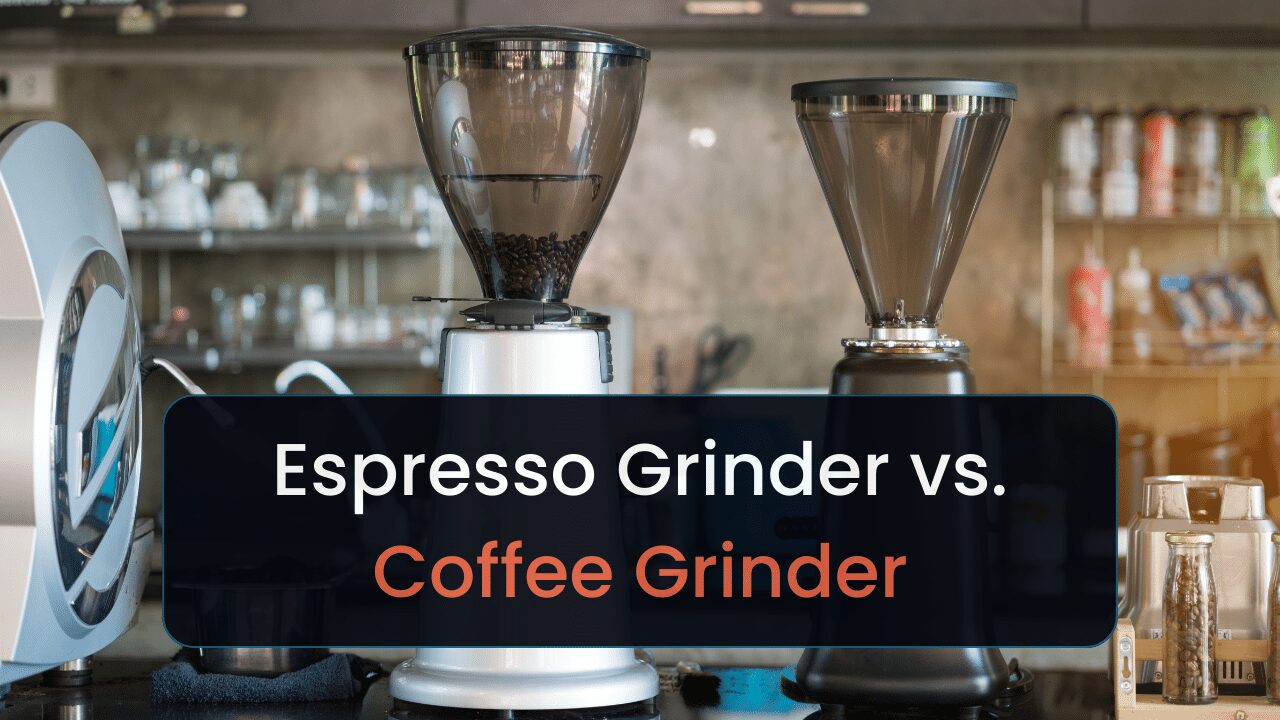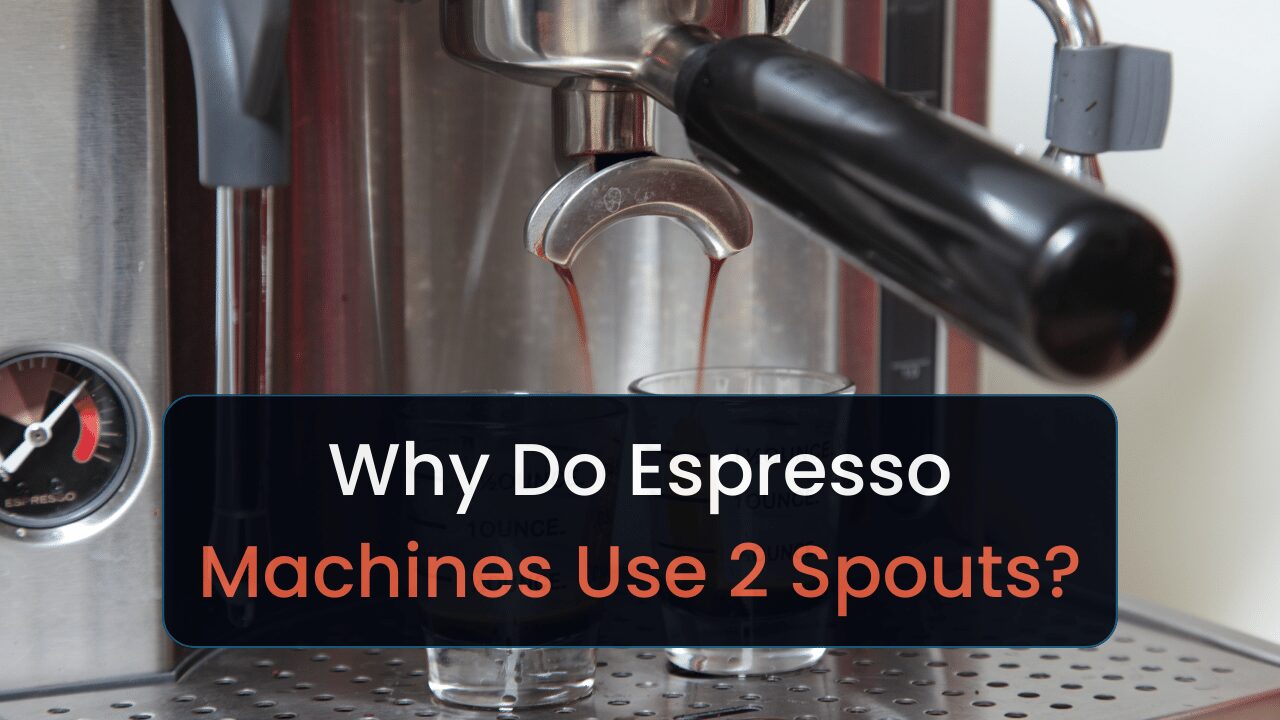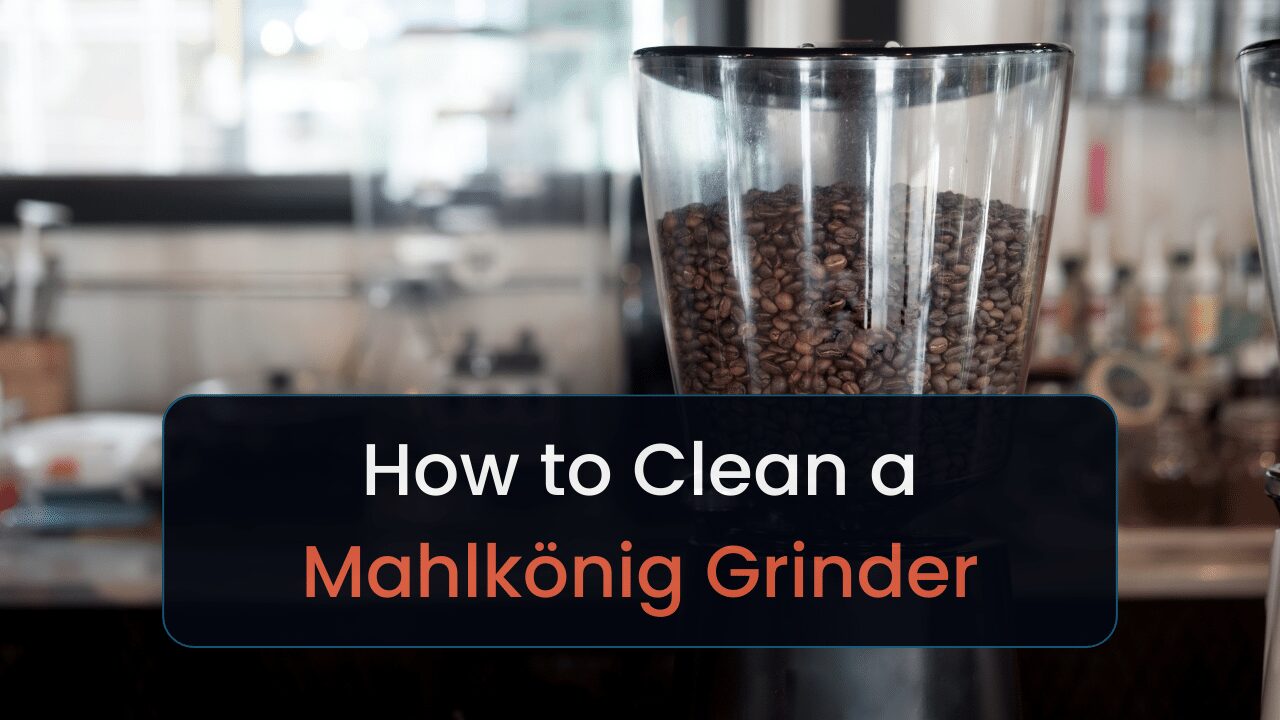But there’s quite a lot more to it than that, so join me as I reveal all about the two main types of coffee grinders. I’ve used both for many years so I can tell you exactly what you need to know about them.
We’ll be going through the following talking points today:
Let’s get started.
Key Takeaways
- Flat burrs are better suited to espresso and other fine blends
- Conical burrs are more versatile but less accurate
- The most affordable option is the conical burr
- The taste of the two are very similar
Flat Burrs vs. Conical Burrs: An Overview
The two main shapes of coffee grinder burr are the flat burr and the conical burr. The burrs are the actual grinding part of the coffee grinder. They rotate together, and the shape of them affects the quality of the grind, the price and more.
In general, I would say that flat burrs are better suited to a professional setting whereas most home users will probably prefer conical burrs.
This is because conical burrs are more versatile than flat burrs but they are less accurate. Flat burrs, on the other hand, are more tailored towards even, fine grinds. I’ll explain why in a moment.
That being said, a lot of flat burr coffee will still work well for more coarse grinds. It just depends on how they’re configured.
Here’s a look at which type of burr is best for which categories. An “X” means it’s the winner in that category:
| Type | Flat | Conical | |
| 1 | Taste | X | |
| 2 | Price | X | |
| 3 | Consistency | X | |
| 4 | Low Noise | X | |
| 5 | Retention | X | |
| 6 | Grind speed | X | |
| 7 | Consistency | X | |
| 8 | Ease of use | X | X |
| 9 | Cleaning | X | |
| 10 | Maintenance | X | X |
| 11 | Fine Grind | X | |
| 12 | Medium Grind | X | X |
| 13 | Coarse Grind | X |
Let’s check out those categories in some more detail.
1. Taste – Flat Burr is the Winner
Supposedly, conical burrs can separate the flavors of coffee more substantially. And some people say that flat burrs accentuate the fruit flavors of coffee whereas conical burrs are better for richer, chocolatey flavors.
But, there’s a lot of disagreement on the matter and not a lot of science to back up either of these points.
I’d be inclined to suggest that the difference in the taste between the two burr shapes isn’t substantial in either direction. It’s more about how long you actually grind up the coffee for, as different grind levels are better suited to particular coffee drinks as we’ll find out shortly.
Some people avoid flat burrs as they generate more heat, which they claim can have a negative effect on the taste of the coffee. However, I’ve found that it doesn’t make much of a difference in my experience.
Technically, conical burrs will generate less heat which some people believe makes the coffee taste better. But again, I think that the difference is negligible at taste.
2. Price – Conical is the winer
One key downside to flat burr grinders is that they’re likely to be more expensive. That’s another reason why conical burrs will probably be better for most people at home. But you do get the extra quality with a flat burr and that can go a long way.
On the other hand, I have come across some pretty expensive conical burr grinders! But cheap flat burr grinders are pretty rare.
The starting price point of a conical burr coffee grinder is a lot lower. So if you’re a beginner or you’re just generally on a budget, this would be the one to go for. That’s why it’s my overall winner.
Although a flat burr would still be better for professional baristas or some more experienced home users.
Here are some prices for coffee grinders:
3. Consistency – Flat burr is the winner
In general, flat burrs are better for finer grinds and conical burrs are better for more coarse grinds.
Let’s take a look at the two types of burrs and which coffee grinds they’re best suited towards in the table below.
| Coffee grinder | Grind size | Best for |
| Flat burr | Extra fine | Espresso, Turkish, pour over, aeropress |
| Conical burr | Fine but versatile through to medium/coarse | French press, Drip coffee, some espresso, cold brew, moka pot, drip coffee, French press, filter coffee |
| Blade* | Coarse, uneven | French press, filter coffee |
*I’ve also included the blade coffee grinder in this table for reference. Although personally, I wouldn’t be buying one of those. If you are interested, you can read more about burrs vs blades here.
So why is this the case? It’s all to do with the distribution of the coffee particles. Flat burrs manage to keep the coffee at a more similar distribution and this means the individual particles are going to be more even in size.
On the flip side, the distribution of a conical burr grinder is likely to be more random and that means it’s not quite so perfect for espresso (although a high quality conical burr coffee grinder can still make a great cup).
In its most basic form, however, conical burrs are better for medium or even coarse grinds because of the more sporadic particle distribution.
4. Low Noise – Conical burr is the winner
The actual shape of the burr doesn’t affect the noise per say. Flat and conical burrs at the same power output and within the same grinder are going to create just about the same level of sound.
However, flat burr coffee grinders are usually going to be more powerful, and this will make them louder.
On the flip side, flat burr coffee grinders are often of a better build quality. This means they’re likely to be more well held together and be made of better materials, and this can combat the harsh noise levels.
Overall, however, I’ve found that conical burrs are going to be quieter than flat burrs most of the time.
Here are the most quiet coffee grinders we have.
5. Retention – Flat burr is the winner
Retention refers to the amount of coffee left behind throughout the grind. The way that flat burrs are positioned in most grinders means that the retention rate is higher, which is good news for waste and for taste.
Conical burrs do tend to have a lower retention rate which means slightly more coffee will be wasted on each grind. Plus, this can cause staleness which will, of course, negatively affect the taste of the coffee.
6. Grind speed – Flat burr is the winner
Flat burr grinders are generally faster than conical burr grinders and this makes them better suited to espresso and other fine grind coffee.
Here’s a look at the kinds of grind speeds you should be aiming for for each different type of coffee.
| RPM Range | Suitable coffee types |
| Up to 200 RPM | French press, filter coffee, cold brew |
| 200 – 1000 RPM | Pour over, moka pot, drip coffee, cold brew |
| 1000 – 3000 RPM | Aeropress, espresso, pour over |
| 3000 RPM + | Espresso |
You’ll usually find that flat burr coffee grinders start at around the 1500 RPM mark. But, they can go all the way up to tens of thousands of RPM!
Conical burr coffee grinders are rarely faster than about 1500-2000 RPM though. You’ll often find them less than 1000 RPM.
7. Consistency – Flat burr is the winner
The shape of a flat burr is… pretty flat. This is great for consistency as the particles move around less, meaning they’re more evenly distributed.
The result of this is that the particles are going to be more even in size and this is better suited to the likes of espresso coffee.
Conical burrs are, as the name suggests, cone shaped. So, they move in a different way to the flat burrs. The distribution is more varied so the size of the particles is more random, which isn’t so perfect for espresso but can be better for more coarse grinds like filter coffee.
You can still use good quality conical burr coffee grinders for a relatively good quality espresso but flat burrs are still better suited to the job overall.
8. Ease of use – It’s a tie
The ease of use between a flat burr and a conical burr coffee grinder is usually quite similar, as the burr shape doesn’t significantly impact the basic user interface or operation of the grinder.
That said, if you consider cleaning part of “ease of use,” then conical burr grinders might be easier.
But remember, the specific design of the grinder can also play a significant role. It’s best to look at reviews and features of individual models when making a choice.
9. Cleaning – Flat burr is the winner
I’ve found that conical burrs are easier to clean. That’s because it’s a little trickier to get in behind a flat burr to clean the rear side of them.
You’ll still need to clean both types of coffee grinder just as often, but the process will be a little easier when you have flat burrs.
To find out more about cleaning a coffee grinder, check out this article.
10. Maintenance – It’s a tie
It’s true that flat burr coffee grinder will last for longer than a conical burr one as it’s probably going to be of a higher build quality so they’re going to be more durable.
But in terms of the actual burrs themselves, maintaining the grinder is going to require the same level of skill overall. A high quality conical burr grinder will require less maintenance and be just as easy to fix as a low quality flat burr grinder.
So, this section is going to be a tie overall.
11. Best for fine grinds – Flat burr is the winner
A flat burr coffee grinder has better consistency and retention as discussed in the previous section.
The particles will be of a similar size and there will be less leftover coffee residue.
That’s the perfect setup for espresso drinks, Turkish coffee, and other types of coffee that require an even and fine grind.
Here are the espresso grinders we offer.
12. Best for medium grinds – It’s a tie
In the medium grind category (for the likes of cold brew and pour over coffee), either type of burr shape will be just as good as each other.
You don’t need super fine and even particles at this level but a flat burr grinder will still be able to deliver a good quality medium grind in the same way that a conical burr will.
13 Best for coarse grinds – Conical burr is the winner
Conical burr coffee grinders are inherently less consistent in their grind. This means that they’re better suited to more coarse grinds such as French press and filter coffee.
Flat burrs generally tend to keep the coffee particle size pretty even whereas conical burrs have a more random output. The latter is perfect for those more coarse grinds.
Here are the grinders we offer for all types of grinds, course grind included.
Flat Burrs: Who are They Best For?
I’d generally recommend flat burrs for more experienced users, e.g. advanced home users or professional baristas. That’s because they’re more specialist and generally more expensive. Plus, they can be less versatile in terms of the coffee drinks you can make with them.
This burr shape is probably going to be wasted on beginners as the supreme quality espresso requires a high level of skill to actually brew after this.
Conical Burrs: Who are They Best For?
I’d recommend this type of burr to home users for the most part as they’re more versatile in terms of the types of coffee drinks you can make. Plus, they can be a lot more affordable.
By the way, even though I recommended flat burrs to commercial users and conical burrs to home users, there’s nothing to say that a high quality conical burr coffee grinder won’t be well suited to a cafe, for example.
This is especially the case if you’re going to be making a lot of filter coffees and such in your cafe.
Flat Burrs vs Conical Burrs FAQ
People have been asking a few more questions about these burr shapes and I’ve got the answers below.
How often do I need to clean my flat burr or conical burr coffee grinder?
It’s best practice to give your coffee grinder a deep clean if you use it every day, and to wipe it down after each use. This will keep your coffee tasting great, and can even prolong the life of the burrs.
I’ve described exactly how to clean your coffee grinder and you can read all about it here.
Which grind speed is best for which burr shape?
Generally, flat burrs coffee grinders will be faster than conical burr grinders. That’s because they’re designed for finer grinds, and finer grinds are better suited to faster grind speeds.
You can read more about why that is and about coffee grinder RPM speeds in general this article.
Should I buy a stainless steel or a ceramic burr grinder?
The most common type of coffee grinder burr material is stainless steel but you might find a ceramic burr from time to time. Each of these materials have their own pros and cons.
Make sure to check out this guide on the differences between ceramic and steel burrs for more information.
Final Thoughts on Flat Burr vs Conical Burr Coffee Grinders
If you’re a home user (especially a beginner), the conical burr is going to be best suited to you. It’s more versatile and affordable but it can still kick start the process for an awesome cup of coffee in most cases.
But if you want to get more technical (especially if you’re working in a cafe), then flat burrs could be better. You’re going to need to budget for them, though.
Now that you’ve picked a flat burr or a conical burr coffee grinder, it’s time to find exactly which grinder model to go for. I’ve put together some of the best ones in this directory.






